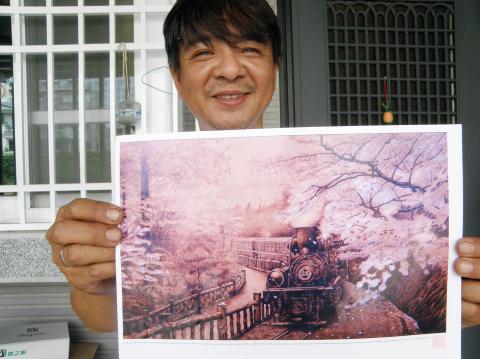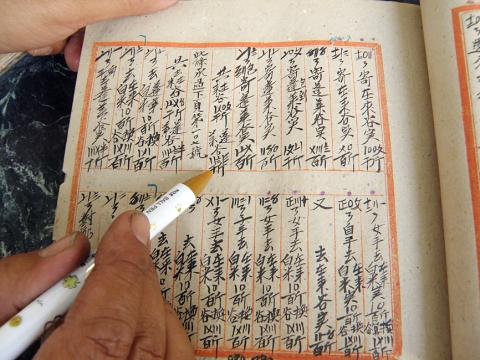|
Artist keeps
Taiwanese numbers system alive
LIVING HISTORY: A uniquely Taiwanese accounting
system using 10 numbers is getting a second lease of life through the dedication
of an artist in Chiayi City
By Yu Hsueh-lan and Jake Chung / Staff reporter, with staff
writer

Artist Wang Yi-yi displays a
pyrograph in Chiayi County on Tuesday last week of the Alishan Railway created
under his guidance by two inmates at the Chiayi Detention Center.
Photo: Yu Hsueh-lan, Taipei Times

Artist Wang Yi-yi points out
special Taiwanese numerals in a rice-mill account book dating from 1947 in his
collection in Chiayi County last Tuesday.
Photo: Yu Hsueh-lan, Taipei Times
Wang Yi-yi (王蟻益), a member of the Chiayi
City arts circle, is trying to revive a dying Taiwanese system of numbers used
in accounting by incorporating them into his works of art, in the hope that
younger generations would once again come to know this system like their
forebears did.
According to Wang, the numbers had once been the accounting system of early
Taiwanese society and had been used by business owners to balance their books.
The system used 10 numbers, each corresponding to its equivalent Arabic number
from 0 to 9, Wang said, adding that even in modern times, some appliance stores
or Chinese medicine stores still use the system.
Wang said that historical data he had studied showed that the system had been in
use as recently as when the Japanese colonized Taiwan. Most older farmers and
fishermen still remember the system, but Wang added that it was impossible to
tell who had created it.
Farmers called the system “Taiwanese numbers” (台灣碼), but the naming seemed to be
adapted by whatever industry used it. Betel nut growers called it “betel nut
digits,” while sugarcane growers called it “sugarcane digits,” Wang said.
As the accounting method using the system of numbers was unique — with the
numbers recorded at the top column of the ledger and the unit of the number in a
lower column, as opposed to side by side — it was hard to change it once the
record had been made, Wang said, adding that it aided accounting accuracy.
Wang said the first time he had incorporated Taiwanese numbers into his artwork
was two years ago, when he designed T-shirts and business-card holders for a
creativity competition.
The success of this endeavor has also seen Wang invited to other events. For
instance, he was recently invited to the Hakka Cultural Exhibit Hall in Chiayi
County’s Sikou Township (溪口) to teach the township residents how to use the
Taiwanese digits on their mailboxes.
Wang doubles as a pyrography instructor at Chiayi City community college.
Pyrography is the art of decorating wood or other materials with burn marks
using a heated object such as a poker.
However, Wang has not always been moonlighting as a teacher at the community
college. Before he came in contact with pyrography five years ago, while surfing
the Internet, Wang worked in the insurance industry.
Saying he had liked to doodle since his youth, Wang attended arts and craft
classes in high school and learned painting from the Modernist painter Tai Ming-te
(戴明德) and the late, renowned painter Tsao Ken (曹根). Against this background,
Wang had immediately taken a liking to pyrography because of its simple beauty.
“I started toying with the genre and gave it a few tries, and I have not been
able to break away since,” Wang said, adding that he started moonlighting at the
community college three years ago.
Wang also accepted an invitation from the Chiayi prison to instruct inmates in
the art of pyrography.
Two talented inmates pooled their resources to make a huge pyrographic artpiece
of Alishan’s (阿里山) trains and blossoming cherry trees that stood out because of
its high level of craftsmanship. The artwork has been selected for a
cross-strait arts and crafts exhibition of inmates’ works, Wang said.
Wang also spreads his and his students’ pyrography works abroad via Facebook,
winning praise from other pyrography artists or admirers in foreign countries.
This has inadvertently helped to promote Taiwan’s image abroad, Wang said.
“However, the majority of foreigners seem to think we are Chinese,” Wang said.
He added that although his English is very poor, with the aid of online
translation software he manages to get the message across to foreign pyrography
art lovers: “We come from the most beautiful island of Taiwan.”
|
![]()
![]()
![]()